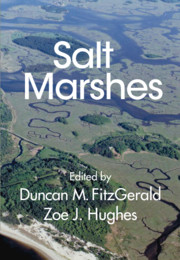Book contents
- Salt Marshes
- Salt Marshes
- Copyright page
- Contents
- Contributors
- Acknowledgments
- 1 State of Salt Marshes
- Part I Marsh Function
- Part II Marsh Dynamics
- Part III Marsh Response to Stress
- 13 Climatic Impacts on Salt Marsh Vegetation
- 14 Impacts of Exotic and Native Species Invading Tidal Marshes
- 15 Marsh Edge Erosion
- 16 Upland Migration of North American Salt Marshes
- 17 Restoration of Tidal Marshes
- 18 Impacts of Climate Change and Sea Level Rise
- Index
- References
18 - Impacts of Climate Change and Sea Level Rise
from Part III - Marsh Response to Stress
Published online by Cambridge University Press: 19 June 2021
- Salt Marshes
- Salt Marshes
- Copyright page
- Contents
- Contributors
- Acknowledgments
- 1 State of Salt Marshes
- Part I Marsh Function
- Part II Marsh Dynamics
- Part III Marsh Response to Stress
- 13 Climatic Impacts on Salt Marsh Vegetation
- 14 Impacts of Exotic and Native Species Invading Tidal Marshes
- 15 Marsh Edge Erosion
- 16 Upland Migration of North American Salt Marshes
- 17 Restoration of Tidal Marshes
- 18 Impacts of Climate Change and Sea Level Rise
- Index
- References
Summary
Recent estimates of global salt marsh area sit at 5.5 million hectares (Mcowen et al. 2017). Conservatively, this translates to $1 trillion of ecosystem services per annum, potentially as much as $5 trillion (De Groot et al. 2012, Mehvar et al. 2018), equivalent to the entire US federal budget for 2019. There can be little debate as to the value of salt marshes, both in terms of the ecosystem services they provide and the key part they play in helping us understand past climate and sea level trends. This chapter summarizes the preceding work and draws together some key observations and notable knowledge gaps highlighted in the previous chapters. We provide a focus on the expected response of salt marshes to the stresses created by a changing climate.
- Type
- Chapter
- Information
- Salt MarshesFunction, Dynamics, and Stresses, pp. 476 - 481Publisher: Cambridge University PressPrint publication year: 2021
References
- 2
- Cited by

